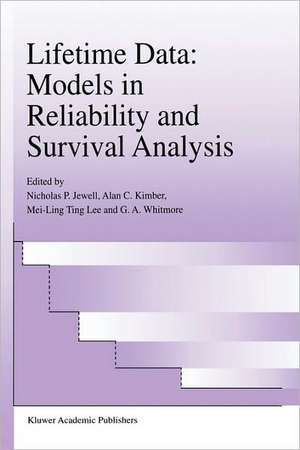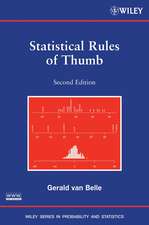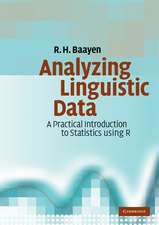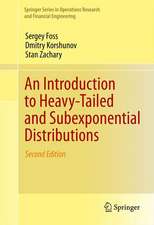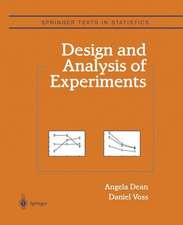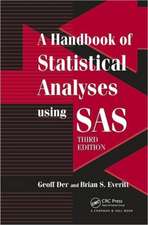Lifetime Data: Models in Reliability and Survival Analysis
Editat de Nicholas P. Jewell, Alan C. Kimber, Mei-Ling Ting Lee, G. Alex Whitmoreen Limba Engleză Hardback – 29 noi 1995
This volume contains a selection of papers based on the 1994 International Research Conference on Lifetime Data Models in Reliability and Survival Analysis, held at Harvard University. The conference brought together a varied group of researchers and practitioners to advance and promote statistical science in the many fields that deal with lifetime and other time-to-event-data. The volume illustrates the depth and diversity of the field. A few of the authors have published their conference presentations in the new journal Lifetime Data Analysis (Kluwer Academic Publishers).
| Toate formatele și edițiile | Preț | Express |
|---|---|---|
| Paperback (1) | 922.46 lei 6-8 săpt. | |
| Springer Us – 2 dec 2010 | 922.46 lei 6-8 săpt. | |
| Hardback (1) | 929.36 lei 6-8 săpt. | |
| Springer Us – 29 noi 1995 | 929.36 lei 6-8 săpt. |
Preț: 929.36 lei
Preț vechi: 1133.36 lei
-18% Nou
Puncte Express: 1394
Preț estimativ în valută:
177.85€ • 187.05$ • 148.60£
177.85€ • 187.05$ • 148.60£
Carte tipărită la comandă
Livrare economică 09-23 ianuarie 25
Preluare comenzi: 021 569.72.76
Specificații
ISBN-13: 9780792337836
ISBN-10: 0792337832
Pagini: 410
Ilustrații: XII, 410 p.
Dimensiuni: 156 x 234 x 24 mm
Greutate: 0.77 kg
Ediția:1996
Editura: Springer Us
Colecția Springer
Locul publicării:New York, NY, United States
ISBN-10: 0792337832
Pagini: 410
Ilustrații: XII, 410 p.
Dimensiuni: 156 x 234 x 24 mm
Greutate: 0.77 kg
Ediția:1996
Editura: Springer Us
Colecția Springer
Locul publicării:New York, NY, United States
Public țintă
ResearchDescriere
Statistical models and methods for lifetime and other time-to-event data are widely used in many fields, including medicine, the environmental sciences, actuarial science, engineering, economics, management, and the social sciences. For example, closely related statistical methods have been applied to the study of the incubation period of diseases such as AIDS, the remission time of cancers, life tables, the time-to-failure of engineering systems, employment duration, and the length of marriages.
This volume contains a selection of papers based on the 1994 International Research Conference on Lifetime Data Models in Reliability and Survival Analysis, held at Harvard University. The conference brought together a varied group of researchers and practitioners to advance and promote statistical science in the many fields that deal with lifetime and other time-to-event-data. The volume illustrates the depth and diversity of the field. A few of the authors have published their conference presentations in the new journal Lifetime Data Analysis (Kluwer Academic Publishers).
This volume contains a selection of papers based on the 1994 International Research Conference on Lifetime Data Models in Reliability and Survival Analysis, held at Harvard University. The conference brought together a varied group of researchers and practitioners to advance and promote statistical science in the many fields that deal with lifetime and other time-to-event-data. The volume illustrates the depth and diversity of the field. A few of the authors have published their conference presentations in the new journal Lifetime Data Analysis (Kluwer Academic Publishers).
Cuprins
Preface. On the Entropies and Mutual Information of Some Bivariate Continuous Distributions Used in Reliability; M. Ahsanullah, M. Habibullah. Initial Conditions Problem in Event History Analysis: An Indirect Inference Procedure; M.Y. An. Analysis of Survival Data Under Competing Risks with Missing Cause of Death Information: Application and Implications for Study Design; J.W. Andersen, et al. Conditional Proportional Hazards Models; B.C. Arnold, Y.H. Kim. A Comparison of Conditional and Unconditional Inference Relating to Log-Gamma Distribution; N. Balakrishnan, P.S. Chan. Universal Formulas for Treatment Effects from Noncompliance Data; A.A. Balke, J. Pearl. Fundational Issues Concerning the Analysis of Censored Data; R.E. Barlow, P. Tsai. Burn-in at the Component and System Level; H.W. Block, et al. Identificationof Dependent Competing Risks Models; K. Carling, T. Jacobson. Reliability Modelling for Optical Amplified Communication Systems; M. Chown, G.A. Whitmore. A Parametric Approach to Measurement Errors in Receiver Operating Characteristic Studies; M. Coffin, S. Sukhatme. Models for Degradation Processes and Event Times Based on Gaussian Processes; K. Doksum, S.-L. Normand. A Non-Parametric Two-Sample Survival Test Based on a Single Occupancy Fermi-Dirac Model for the Discrete Range Distribution; J.T. Efird, F. Pardo. Probability Approximations and Inequalities for Sequential Tests; J. Glaz, J.R. Kenyon. Cure Mixture Models in Breast Cancer Survival Studies; N.H. Gordon. A General Approach to Derive Chi-Square Type of Goodness-of-Fit Tests for Lifetime Data; S. Hawala, J.-L. Wang. Prediction in Survival Analysis: Model or Medic?; R. Henderson, M. Jones. Dynamic Reliability Models; M. Hollander, E.A. Peña. Generalizations of Current Status Data with Applications; N.P. Jewell, M. van der Laan. Trend Analysis of Multiple Counting Processes; T. Kamakura. Historical Controls and Model Survival Analysis; N. Keiding. A Random Effects Model for Multivariate Life Data; A.C. Kimber. Statistical Challenges in Comparing Chemotherapy and Bone Marrow Transplantation as a Treatment for Leukemia; J.P. Klein, M.-J. Zhang. Maximum Likelihood Estimation and the Multivariate Bernoulli Distribution: An Application to Reliability; P.H. Kvam. Intermediate Clinical Events, Surrogate Markers and Survival; M. Lefkopoulou, M. Zelen. A Semiparametric Bootstrap for Proportional Hazards Models; T.M. Loughin, K.J. Koehler. Application of Cox Regression with a Change Point in Clinical Studies; X. Luo, et al. Burn-in with Age Replacement; A.W. Marshall. Fitting Cox's Proportional Hazards Model Using Grouped Survival Data; I.W. McKeague, M.-J. Zhang. Statistical Methods for Dependent Competing Risks; M.L. Moeschberger, J.P. Klein. Orthogonal Functions of Inverse Gaussian Disbrituions; R. Nishii. Statistical Models for Quality of Life Measures; Y. Palesch, A.J. Groos. Nonparametric Estimation of Regression Parameters from Censored Data with Two Discrete Covariates; M.H. Rahbar. Locally Efficient Median Regressionwith Random Censoring and Surrogate Markers; J.M. Robins. Survival Models for Heterogeneity Using the Non-Central Chi-Squared Distribution with Zero Degrees of Freedom; C.S. Rocha. Efficiently Weighted Estimating Equations with Application to Proportional Excess Hazards; P. Sasieni. Sequential Multi-Hypothesis Testing in Software Reliability; J.S. Shieh, Y.L. Tong. Assessing Gamma Frailty Models for Clustered Failure Time Data; J.H. Shih,
